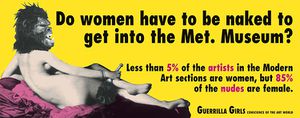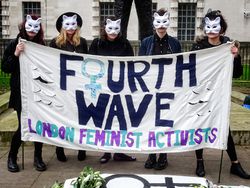What was the Third Wave Feminist Movement
Previous DailyHistory articles have discussed the First and Second Wave Feminist Movements. Like Second Wave feminism, Third Wave feminism emerged from some of the failures and conversations left behind from the wave before.
While there were many successes of the first two waves, including voting rights and greater access to reproductive control, Third Wave feminists have argued that these successes primarily benefited white middle-class women. The Third Wave feminists have actively sought to expand the rights of LBTQ and minority women. Mainly, they have been interested in trying to achieve parity with white women.
Background

As is common with any large coalition, group goals need to be broad enough to encompass the desires of the majority of those involved. White, educated women with clout during the First Wave often advanced the need for white women's rights by suggesting they were better educated and equipped to exercise those rights than non-white men and women.
During the Second Wave, the general discussions about reproductive choice were often framed in terms of access to birth control and the right to an abortion for white women. While non-white women were fighting for the right to control reproduction on their own terms, and not to be forcibly sterilized. These rifts were not crippling, but often benefited one faction of a coalition more than the other.
For many non-white feminists during the Second Wave, their experiences as women were inseparable from their experiences as people of color. They could not compartmentalize their lives or experiences. A new wave of feminism needed to address all parts of their identity adequately.
Third Wave Feminism
Leaders of the third wave feminist movement were daughters of the second wave--often literally. They were born in the 1960s and 1970s and came of age in the 1980s and 1990s. They came of age after the Civil Rights movement and benefited from that in many ways--growing up in diverse neighborhoods, attending integrated schools, and seeing representations and contributions of people of color in media and society. Furthermore, these leaders were often the daughters of those who saw society transform because of Second Wave actions and expected their daughters to take advantage of those opportunities.
Third Wave Feminism differed from the first two waves not just goals, but in substance. While the first two waves generally accepted traditional gender identities and norms, the third wave challenged ideas about what was traditionally masculine and traditionally feminine. Not only did Third Wave feminists reject this strict separation and polarity between male and female, but they embraced a more complex and nuanced understanding of opportunities for gender and sexual expression, including identity.
Third Wave feminists took Second Wave feminism's "sexual liberation" one step further by also calling for the exploration and acceptance of a variety of sexual identities. Furthermore, Third Wave Feminists believe it is in their right to seek sexual pleasure on their own terms as well as a sex-positive movement.
Feminism in the Third Wave appropriated previously-insulting and derogatory terms. Third Wave Feminists unapologetically reclaimed words like "bitch" and spoke openly about themselves, their bodies, and their experiences. Third Wave Feminists, whose lives have been saturated with popular culture, are quick to challenge portrayals of women in beauty and in art. Third Wave Feminists see men as their equals and challenge institutions and conventions that dictate otherwise.[1]
Some have argued that Third Wave Feminism is--in part--a rejection of Second Wave Feminism or at least a strong critique against it. If Second Wave Feminism bolstered heterosexual privilege, Third Wave Feminism combats that by supporting the extension of civil rights to LGBT individuals. If Second Wave Feminism was empowering by rejecting conventional beauty ideals, Third Wave Feminism calls for an inclusive definition of beauty that includes a more diverse set of criteria.[2]
At its core, Third Wave Feminism argues that it is more inclusive and accepting of a variety of identities. Third Wave Feminism attempts to wrestle more fully with intersectionality, that is: that race and gender are not "mutually exclusive categories of experience and analysis... Those who are multiply-burdened... cannot be understood" through a single lens or source of discrimination.[3].
Third Wave Feminism does try to check its privilege at the door, it, like its predecessors, still does tend to have a white-middle class leaning. While this has been more openly discussed, it still also remains a point of contention for some feminists in the Third Wave with some feminists calling for toleration and others for more ardent antiracism.
Third Wave Feminism, like its predecessors, embodies a variety of opinions and beliefs and is not limited to just "women's issues;" nevertheless, these issues remained at the core of Third Wave Feminism's discussions.
Fourth Wave Feminism?
Related Articles
Some have argued that #MeToo movement, the 2016 Presidential Election, the appointment of Brett Kavanaugh to the Supreme Court and the revelations about how common the sexual assault of women is may have ushered in a Fourth Wave of Feminism. Both sexual assault and harassment have become central issues within the existing movement. Only time will tell if this is an entirely new movement, or if this is simply a continuation of the Third Wave after a dormant period. If this is a new Fourth Wave, it is clearly building on some of the Third Wave but is unique in its focus on sexual harassment and rape culture.
Suggested Reading
- The Women's Movement Today: An Encyclopedia of Third Wave Feminism, ed. Leslie L. Heywood, (Greenwood, 2005)
- Third Wave Feminism: A Critical Exploration, 2nd edition, ed. Stacy Gillis, Gillian Howie, and Rebecca Munford, (Palgrave Mcmillian, 2007)
References
- Jump up ↑ Laura Brunell and Elinor Burkett, "Feminism: Sociology," Encyclopedia Britannica, https://www.britannica.com/topic/feminism#ref216004
- Jump up ↑ R. Claire Snyder, "What is Third Wave Feminism? A New Directions Essay," Signs 34, 1 (Autumn 2008): 175-196.
- Jump up ↑ Kimberle Crenshaw, "Demarginalizing the Intersection of Race and Sex: A Black Feminist Critique of Antidiscrimination Doctrine, Feminist Theory and Antiracist Politics," Unversity of Chicago Legal Forum, vol. 1989, no. 1: 139-167, 139-140.


